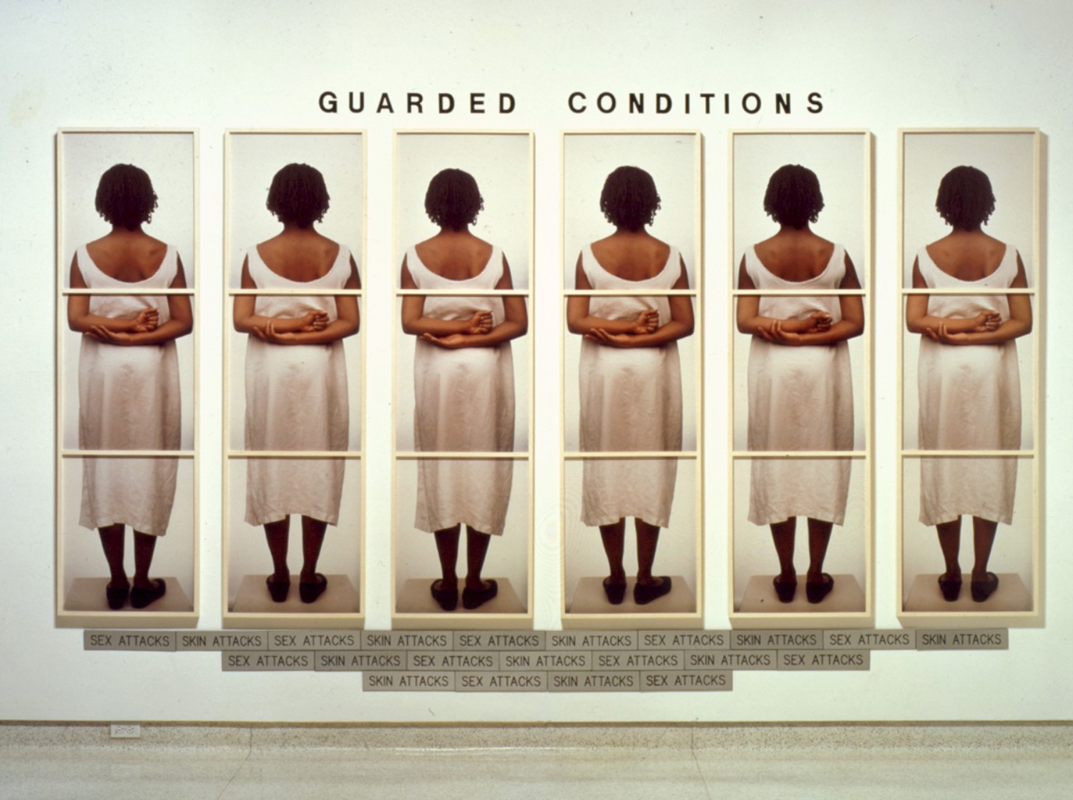More about Guarded Conditions

Contributor
Are the women in the Lorna Simpson’s photographs looking at something that the audience is supposed to be looking at, but instead is busy staring at the women’s backs?
And then, that staring, is that part of the “skin attacks” and “sex attacks”? And then, the title hanging above the photos, like some kind of anthropological exhibition which suggests that yes, staring is bad. But then, it’s so pretty, can’t not stare.
Simpson has spent her career trying to figure out how to be both the audience and the performer. She began making photographs when her mother’s bad photos from a dance recital left her “devastated.” She felt that in order to avoid more emotional trauma she’d better quit dance and take the pics herself.
Not that she works in an autobiographical sort of way, she’ll make that very clear. More like, it seems a shame to put all the work into a performance and not get to see it; plus when the audience responds to a performance they become a part of it. Guarded Conditions is like a really dark joke about that tension...except it’s not funny.
Simpson says that Brooklyn, where she works, is always “beckoning [her] to steal or admire.” Perhaps the same way that the woman pictured above beckons while also implicating the inherent violence of looking.
She’s often mushed together with Glenn Ligon, that other artist of words and photos, and she’s absolutely not about it. It’s easy to see Simpson’s work in terms of identity politics, but it’s also lazy. “When I get up in the morning and I look in the mirror, I don’t look at Black content, I’m just looking at myself.”
And really, Guarded Conditions could be any of us: hiding our faces from group selfies, staring at our computer screens, being unknowingly ogled by millions of strangers. She made this the same year the Berlin Wall fell (1989), but it seems that she could have titled it “every single day of the 21st century, also p.s. I can see the future.”
Sources
- A World of Art: Works in Progress Lorna Simpson. Created by Henry M. Sayre. 1996. Burlington: Annenberg/CPB Project. jpuffer1944:YouTube Channel. Accessed August 24, 2017. https://www.youtube.com/channel/UCqx787nnWoxbsbX-fsparnw
- Copeland, Huey. “‘Bye, Bye Black Girl’: Lorna Simpson’s Figurative Retreat.” Art Journal Vol. 64 No. 2: Summer 2005, 62-77. Accessed August 24, 2017. http://lemagazine.jeudepaume.org/2013/08/bye-bye-black-girl-lorna-simps…
- Retta, Sofía. April 28, 2015. “Sex Attacks, Skin Attacks: Black Feminism in the Art of Lorna Simpson.” Medium: Black Feminism. Accessed August 24, 2017. https://medium.com/black- feminism/sex-attacks-skin-attacks-black-feminism-in-the-art-of-lorna-simpson
- Simpson, Lorna, Interviewed by William J. Simmons. “Artists at Work: Lorna Simmons.” Interview Magazine, August 23, 2016. Accessed August 24, 2017. http://www.interview magazine.com/art/artists-at-work-lorna-simpson
- Simpson, Lorna. December 18, 2013. “TEDx Met: Icons – Lorna Simpson.” TEDx Talks: YouTube Channel. Accessed August 24, 2017. https://www.youtube.com/watch?v=xufVY0yEe FQ
- Sternberg, Amandla and Mars. July 22, 2016. “Art Hoe Collective Meets Lorna Simpson.” Tate: YouTube Channel. Accessed August 24, 2017. https://www.youtube.com/watch?v=gtGFgfzekjM
- TateShots. March 20, 2014. “TateShots: Lorna Simpson – Studio Visit.” Tate: YouTube Channel. Accessed August 24, 2017. https://www.youtube.com/watch?time_continue=215&v= dNk098ffjLM











